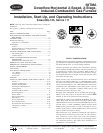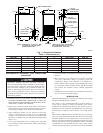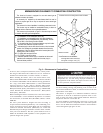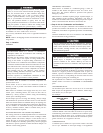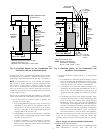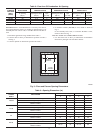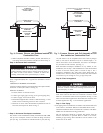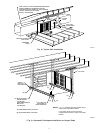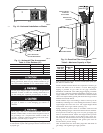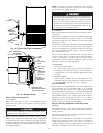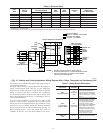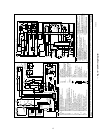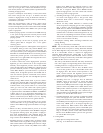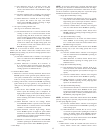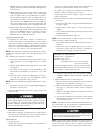
Improper installation, adjustment, alteration, service, mainte-
nance, or use can cause carbon monoxide poisoning, explo-
sion, fire, electrical shock, or other conditions which may
cause personal injury, loss of life, or property damage.
Consult a qualified installer, service agency, local gas sup-
plier, or your distributor or branch for information or assis-
tance. The qualified installer or agency must use only
factory-authorized and listed kits or accessories when modi-
fying this product. A failure to follow this warning could
result in electrical shock, fire, personal injury, or death.
For high-altitude installation, the high-altitude conversion kit must
be installed at or above 5500 ft above sea level.
For accessory installation details, refer to applicable installation
literature.
NOTE: Remove all shipping brackets and materials before oper-
ating furnace.
Step 1—Location
GENERAL
DO NOT install furnace in a corrosive or contaminated
atmosphere. Make sure all combustion and circulating air
requirements are followed.
DO NOT use this furnace during construction when adhe-
sives, sealers, and/or new carpets are being installed and
curing. If the furnace is required during construction, use
clean outside air for combustion and ventilation. Compounds
of chlorine and fluorine when burned in combustion air form
acids which will cause corrosion of the heat exchangers and
metal vent systems. Some of these compounds are released
from paneling and dry wall adhesives, paints, thinners,
masonry cleaning materials, and many other solvents com-
monly used in the construction process.
Excessive exposure to contaminated combustion air will
result in safety and performance related problems.
This furnace must be installed so electrical components are
protected from water.
Locate furnace as near to center of air distribution system and
chimney or vent as possible. The furnace should be installed as
level as possible.
When furnace is installed so that supply ducts carry air to areas
outside space containing furnace, the return air must also be
handled by a duct(s) sealed to furnace casing and terminating
outside space containing furnace.
Provide ample space for servicing and cleaning. Always comply
with minimum fire protection clearances shown on unit clearance
label. This furnace shall not be installed directly on carpeting, tile,
or any combustible material other than wood flooring. The furnace
may be installed on combustible flooring when installed with
accessory downflow subbase, which is available from your dis-
tributor or branch when required.
LOCATION RELATIVE TO COOLING EQUIPMENT
The cooling coil must be installed parallel with or on downstream
side of furnace to avoid condensation in heat exchangers. When
installed parallel with furnace, dampers or other means used to
control the flow of air must prevent chilled air from entering
furnace. If dampers are manually operated, they must be equipped
with means to prevent operation of either unit unless damper is in
full-heat or full-cooling position.
HAZARDOUS LOCATIONS
When furnace is installed in a residential garage, it must be
installed so that burners and ignition source are at least 18 in.
above floor. The furnace should be protected from physical
damage by vehicles.
When furnace is installed in public garages, airplane hangars, or
other buildings having hazardous atmospheres, unit must be
installed in accordance with recommended good practice require-
ments of the National Fire Protection Association, Inc.
Step 2—Air for Combustion and Ventilation
Provisions for adequate combustion and ventilation air must be
provided in accordance with Section 5.3, Air for Combustion and
Ventilation, of the NFGC or applicable provisions of localbuilding
codes.
Canadian installations must be in accordance with NSCNGPIC
and all authorities having jurisdiction.
Air for combustion must not be contaminated by halogen
compounds which include fluoride, chloride, bromide, and
iodide. These elements are found in aerosol sprays, deter-
gents, bleaches, cleaning solvents, salts, air fresheners, and
other household products.
The operation of exhaust fans, kitchen ventilation fans,
clothes dryers, or fireplaces could create a negative air
pressure condition at the furnace. Make-up air must be
provided for these devices, in addition to that required by the
furnace.
All fuel-burning equipment must be supplied with air for combus-
tion of the fuel. Sufficient air MUST be provided to ensure there
will not be a negative pressure in equipment room or space. In
addition, a positive seal MUST be made between furnace cabinet
and return-air duct to avoid pulling air from the burner area and
draft safeguard opening into circulating air.
The requirements for combustion and ventilation air depend upon
whether furnace is located in a CONFINED or UNCONFINED
space.
UNCONFINED SPACE
An unconfined space must have at least 50 cu ft for each 1000
Btuh of input for all appliances (such as furnaces, clothes dryer,
water heaters, etc.) in the space.
For Example:
58TMA FURNACE
HIGH-FIRE INPUT
BTUH
MINIMUM SQ FT
WITH
7-1/2 FT CEILING
63,000 420
84,000 560
105,000 700
123,000 820
If space is constructed unusually tight, air for combustion and
ventilation MUST come from either the outdoors or spaces freely
communicating with outdoors. Combustion and ventilation open-
ings must be sized the same as for a confined space as defined
below. Return air must not be taken from the room unless equal or
greater amount of air is supplied to the room.
CONFINED SPACE
A confined space is defined as a space whose volume is less than
50 cu ft per 1000 Btuh of total input ratings of all appliances
4
→



